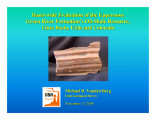TO
| Title | Date | Subject | Description | ||
|---|---|---|---|---|---|
| 76 |
 |
Basin-wide evaluation of the uppermost Green River Formation's oil-shale resource, Uinta Basin, Utah and Colorado | 2008 | Green River; Uinta Basin; Utah; Colorado; Crude oil; Green River Formation; Oil; Gas; Oil yield; Oil shale; Oil-shale thickness; Mahogany zone; R-7; Parachute Creek Member; Richness grade; Uintah County; Salt Lake Base Line and Meridian; BLM; U.S. Bureau of Land Management | Due to the recent increase in crude oil prices and concerns over diminishing conventional reserves, the Utah Geological Survey has reexamined the Uinta Basin's oil-shale resource, primarily in the Mahogany zone of the Green River Formation. Past assessments, the first conducted in 1964 and subsequen... |
| 77 |
 |
Basin-wide evaluation of the uppermost Green River Formation's oil-shale resource, Uinta Basin, Utah and Colorado | 2008-11-13 | Presentaion; Green River formation; Oil shale; Uinta Basin; Utah; Colorado; Oil-shale resource evaluation; UGS; Isopach maps | Scope--Oil Shale Resource Evaluation: 1) Focus - Entire Uinta Basin - Data from 293 wells spread throughout the Uinta Basin 2) Determined thickness of continuous intervals averaging 50, 35, 25, and 15 gallons per ton (GPT) 3) Created GIS-based maps - Isopachs for each richness zone - Overburden thic... |
| 78 |
 |
Bibliography of oil-impregnated rock deposits of Utah | 1979-11 | ||
| 79 |
 |
Bibliography of tar sand deposits in Utah | 1987 | ||
| 80 |
 |
Biofuels--snake oil for the twenty-first century | 2008-12-01 | Most Americans are painfully aware that our present consumption of petroleum is unsustainable. The United States has less than 5% of the world's population, but consumes 24.4% of the world's petroleum production. Only 8.5% of the world's petroleum production comes from American wells, which necessit... | |
| 81 |
 |
Biological markers from Green River kerogen decomposition | 1981-09 | Isoprenoid and other hydrocarbons that are formed in living organisms and preserved in ancient sediments are often called biological markers. The purpose of this paper is to develop improved methods of using isoprenoid hydrocarbons to trace petroleum or shale oil to its source. It is demonstrated th... | |
| 82 |
 |
Biomakers in oil shale: Occurrence and applications | 1982-10 | Biological markers, compounds derived essentially unchanged from living organisms, are found in oil-bearing rocks, petroleum and most ancient sediments. We are investigating the variation in ratios of certain biomarkers in shale oils and their use as tracers for relating oil to source rock during in... | |
| 83 |
 |
Bitumen and very heavy crude upgrading technology: A review of long term R&D opportunities | 2004-03-31 | bitumen; very heavy crude; upgrading technology; R&D opportunities; upgrade bitumen; oil sands bitumen | The Focus of this Review: This review has focused on the identification of emerging and developing technologies that can, when fully developed, either be applied directly to upgrade bitumen and very heavy crudes, or are integral to new approaches to upgrading. Although very heavy crudes do not have ... |
| 84 |
 |
Bitumen deposits of northwest Alabama | 1987 | bitumen deposits; northwest Alabama deposits; bituminous rocks | Bituminous rocks of Mississippian age crop out in northwest Alabama within a 113-km (70-mi) long belt. Bitumen deposits have been confirmed by coreholes to be present in the subsurface for a distance of at least 16-24 km (10-15 mi) south of the outcrop. Geochemical analyses indicate the bitumen to b... |
| 85 |
 |
Bitumen extraction and treatment and reuse of process water | 2009-04-13 | bitumen extraction; bitumen treatment; reuse of process water; produced water; crude oil production; gas production; pressure-assisted ozonation technology; oil removal from water; wastewater treatment; hydrocarbon removal | Produced water from gas and crude oil production is voluminous, requiring extensive treatment before it can be safely discharged or reused. This project has used a newly developed pressure-assisted ozonation technology to remove oil from water and prevent oil sheen at the water surface. The new proc... |
| 86 |
 |
Bitumen recovery from tar sands | 1984-09-11 | Patent; Bitumen recovery; Tar sands; Kerosene; Flotation cell; Bitumen | A process for recovering bitumen from tar sands wherein the tar sands are pretreated with a diluent, such as kerosene in the preferred embodiment, to lower the viscosity of the bitumen such that it is in the range of about 5 to about 20 poise at the digestion temperature. The tar sands are then dige... |
| 87 |
 |
Bituminous sands and some legal aspects of leasing | 1964 | A brief description of the more important bituminous sand deposits of Utah at Asphalt Ridge, Sunnyside, Whiterocks River, and other localities. Discussion of their probable origin and present physical qualities with comparison to liquid oil and natural solid bitumen deposits in Utah. Capsule history... | |
| 88 |
 |
Bituminous sands and viscous crude oils | 1964-10-10 | Bituminous sands; Viscous crude oils; Rocky Mountain region; Low gravity; high viscosity; Heavy crude oil; Quiet Revolution; Thermal recovery; Utah; Bituminous sandstone deposits | Bituminous sandstones of the Rocky Mountain region contain large reserves of low gravity, highly viscous oil that can be recovered at costs equal to or less than the cost of finding and producing oil from conventional methods. Heavy crude oil is defined as "oil which cannot be produce through the no... |
| 89 |
 |
Bituminous sandstone and limestone deposits of Utah | 1963 | The significant bituminous sandstone and bituminous Limestone deposits of Utah are located within, or on the edges of, the Uinta Basin. They are all located within the boundaries of Carbon, Duchesne, and Uintah Counties. The Sunnyside deposits in Carbon County contain the greatest reserves of bitumi... | |
| 90 |
 |
Bituminous sandstone deposits Asphalt Ridge | 1966-12 | Asphalt Ridge probably is the second largest bituminous sandstone deposit in northeastern Utah's Uinta Basin. Discontinuous concentrations of bitumen occur in the Rim Rock Sandstone of the Mesaverde Group of Cretaceous age, in the overlying Uinta Formation of Eocene age and the Duchesne River Format... | |
| 91 |
 |
Bituminous sandstones in the Uinta Basin | 1964 | The largest single deposit of bituminous sandstones in the United States is found in the Uinta Basin. This deposit along with two other well known occurrences of bituminous sandstones in the northeastern portion of the basin have proved reserves exceeding 1% billion barrels of oil. The reserve calcu... | |
| 92 |
 |
Brief history and recent developments in tar sand deposits of Uinta Basin | 1985 | Commercial production of oil from bituminous sandstones, more commonly referred to as "Tar sands", is considered by many to be a viable project. These so-called "heavy oil" deposits represent a very considerable reserve of oil for the future. The Uinta basin is Mother Nature's storehouse of exotic b... | |
| 93 |
 |
Business aspects in oil sands production in the USA | 2006-09-21 | Temple Mountain Energy; Oil sand production; Oil; Natural gas; Electricity; Oil prices; Heavy oil; Oil sands; Business; Economic; SAGD; Steam assisted gravity drainage | The world economic challenge: What is the most important economic resource known? 1-Energy production-Oil, natural gas and electricity are the biggest players 2-China and India economic development (2/3rds of world)-Huge unexpected demands for these resources (now and future)-Especially oil-Fuels, a... |
| 94 |
 |
California plio-miocene oils: Evidence of early generation | 1987 | plio-miocene oils; California oil; source rocks; commercial generation; LOM; hydrocarbon concentration; oil quality | Early generation of oil from Monterey and equivalent source rocks may well be the primary controlling factor on oil quality in the coastal basins of California. Commercial generation has occurred at reflectance levels as low as 0.3% R0. The wide range of chemical characteristics of these oils is com... |
| 95 |
 |
California production statistics-1999: Production by company | 1999 | 1999 Annual Report | |
| 96 |
 |
Capitol Reef-Miners Mountain oil-impregnated rock occurrences | 1967 | The Capitol Reef bituminous sandstone area occurs mainly on the northern and northeastern portions of the area known as Miners Mountain. This is a dome structure of the Teasdale anticline, the axis of which parallels the Teasdale fault system. | |
| 97 |
 |
Carbon capture and sequestration: A regulatory gap assessment - Topical report | 2012-04 | carbon capture and sequestration; gap assessment; CCS; climate change | Though a potentially significant climate change mitigation strategy, carbon capture and sequestration (CCS) remains mired in demonstration and development rather than proceeding to full-scale commercialization. Prior studies have suggested numerous reasons for this stagnation. This Report seeks to e... |
| 98 |
 |
Carbon dioxide sequestration: Effect of the presence of sulfur dioxide on the mineralogical reactions and on the injectivity of CO2+SO2 mixtures | 2010-01 | Carbon dioxide sequestration; CO2; Sequestration stream; Gas injection; CO2+SO2 mixture; Brine; Arkose; Calcite; Anhydrite; Calcium carbonate; CaCO3; Ankerite; Absolute permeabilities; Free-gas; Dissolved gas distribution; Saline formation; Contaminant gases; sulfur dioxide; SO2; Hydrogen sulfide; H... | This report presents experimental and modeling data on certain aspects of carbon dioxide (CO2) sequestration. As different processes are developed and implemented to facilitate the capture of CO2, other contaminant gases (sulfur dioxide, hydrogen sulfide and ammonia) may be present in the sequestrat... |
| 99 |
 |
Catalytic and thermal effects in the upgrading of bitumen-derived heavy oils (Abstract only) | 1985 | Heavy oils derived from PR Spring bitumen were hydrotreated in the fixed bed reactor as a function of process variables. The presulfided commercial NiMo/y-alumina (HDN) catalyst, Mo supported on y-alumina (HDM) catalyst and sodium-impregnated HDN catalyst support were used in this study to investiga... | |
| 100 |
 |
Catalytic upgrading of a Uinta Basin bitumen over a commercial HDM catalyst | 1994 | catalytic upgrading; Uinta Basin bitumen; commercial HDM catalyst | Uinta Basin bitumen was hydrotreated over a sulfidcd commercial Ni-Mo on alumina hydrodemetallation catalyst. The catalyst was on-stream continuously for over 1.000 hours. The extent of heteroatoni removal, residuum conversion and molecular weight reduction were investigated as a function of process... |
